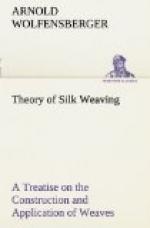[Page 6] This beneficial influence cannot fail to exert itself from the standard of the higher employer down to that of the weaver, who would naturally take more pains and interest in his work than if he were a mere mechanical appendage to his loom in order to keep it in motion.
Very little has been done in his country for technical education as far as the silk industry is concerned, and it was on this special branch, that prompted the author to offer in the present little work a treatise on the theory of shaft weaving for broad silks and ribbons.
It is divided into three principal parts:
#1st. Drawing-in the warp in the
harness.
2nd. The weaves and their application.
3rd. Decomposition or analysis of
the cloth.#
To the foregoing there have been added in the revised and enlarged edition several additional parts covering the following: Jacquard weaves, box loom weaves, including crepes, and cost calculations for plain and fancy weaves.
The subject while condensed, is made as clear and comprehensible as possible, and to many desirous of increasing their knowledge in this direction, this should prove a valuable help.
The author, through the medium of this work, hopes to win the approval and encouragement of the manufacturers, and will feel amply repaid should his efforts tend to develop a deeper interest in the “Queen of Textiles.”
* * * * *
[Page 7] theory of silk weaving
DRAWING-IN
With this term we designate the operation preceding the weaving, by which all the warp-threads are drawn through the heddles of the harness.
The order in which this is done varies according to the weave and the nature of the fabric to be produced; so we distinguish:
#Straight draws, Skip draws, Point draws, Section draws.#
* * * * *
STRAIGHT DRAWS
[Illustration: Fig. 1]
* * * *
[Page 8] [Illustration: Fig. 2]
These form the simplest and most common method of drawing-in. We begin with the first heddle on the left side of the shaft nearest to the warp-beam, then take the first heddle of second shaft and so on until all the shafts the set contains are used in rotation. This completes one “draw,” and this operation is repeated until all the warp-threads are taken up.
The method of making the shaft nearest to the warp-beam the first, is almost universal with the silk business and is technically called drawing-in from back to front.
The opposite, or drawing in from front to rear, is used occasionally, however, and in this case makes the first heddle on the left hand side of the front shaft No. 1.




